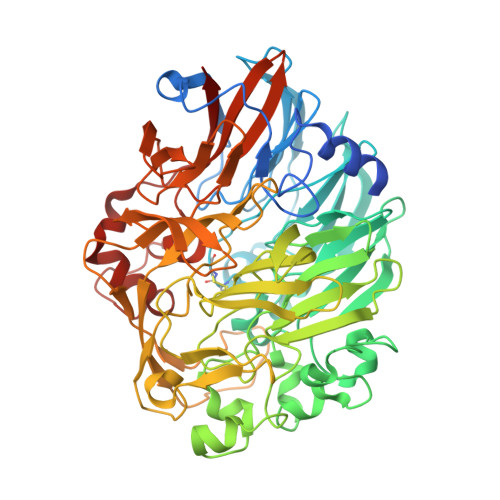Neodymium as Metal Cofactor for Biological Methanol Oxidation: Structure and Kinetics of an XoxF1-Type Methanol Dehydrogenase.
Schmitz, R.A., Picone, N., Singer, H., Dietl, A., Seifert, K.A., Pol, A., Jetten, M.S.M., Barends, T.R.M., Daumann, L.J., Op den Camp, H.J.M.(2021) mBio 12: e0170821-e0170821
- PubMed: 34544276
- DOI: https://doi.org/10.1128/mBio.01708-21
- Primary Citation of Related Structures:
7O6Z - PubMed Abstract:
The methane-oxidizing bacterium Methylacidimicrobium thermophilum AP8 thrives in acidic geothermal ecosystems that are characterized by high degassing of methane (CH 4 ), H 2 , H 2 S, and by relatively high lanthanide concentrations. Lanthanides (atomic numbers 57 to 71) are essential in a variety of high-tech devices, including mobile phones. Remarkably, the same elements are actively taken up by methanotrophs/methylotrophs in a range of environments, since their XoxF-type methanol dehydrogenases require lanthanides as a metal cofactor. Lanthanide-dependent enzymes seem to prefer the lighter lanthanides (lanthanum, cerium, praseodymium, and neodymium), as slower methanotrophic/methylotrophic growth is observed in medium supplemented with only heavier lanthanides. Here, we purified XoxF1 from the thermoacidophilic methanotroph Methylacidimicrobium thermophilum AP8, which was grown in medium supplemented with neodymium as the sole lanthanide. The neodymium occupancy of the enzyme is 94.5% ± 2.0%, and through X-ray crystallography, we reveal that the structure of the active site shows interesting differences from the active sites of other methanol dehydrogenases, such as an additional aspartate residue in close proximity to the lanthanide. Nd-XoxF1 oxidizes methanol at a maximum rate of metabolism ( V max ) of 0.15 ± 0.01 μmol · min -1 · mg protein -1 and an affinity constant ( K m ) of 1.4 ± 0.6 μM. The structural analysis of this neodymium-containing XoxF1-type methanol dehydrogenase will expand our knowledge in the exciting new field of lanthanide biochemistry. IMPORTANCE Lanthanides comprise a group of 15 elements with atomic numbers 57 to 71 that are essential in a variety of high-tech devices, such as mobile phones, but were considered biologically inert for a long time. The biological relevance of lanthanides became evident when the acidophilic methanotroph Methylacidiphilum fumariolicum SolV, isolated from a volcanic mud pot, could only grow when lanthanides were supplied to the growth medium. We expanded knowledge in the exciting and rapidly developing field of lanthanide biochemistry by the purification and characterization of a neodymium-containing methanol dehydrogenase from a thermoacidophilic methanotroph.
Organizational Affiliation:
Department of Microbiology, Radboud University, Nijmegen, The Netherlands.

















